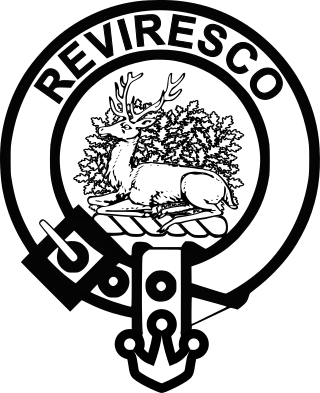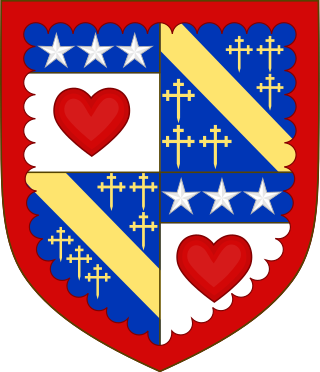
James V was King of Scotland from 9 September 1513 until his death in 1542. He was crowned on 21 September 1513 at the age of seventeen months. James was the son of King James IV and Margaret Tudor, daughter of Henry VII of England. During his childhood Scotland was governed by regents, firstly by his mother until she remarried, and then by his second cousin, John Stewart, Duke of Albany. James's personal rule began in 1528 when he finally escaped the custody of his stepfather, Archibald Douglas, 6th Earl of Angus. His first action was to exile Angus and confiscate the lands of the Douglases.

James I was King of Scots from 1406 until his assassination in 1437. The youngest of three sons, he was born in Dunfermline Abbey to King Robert III and Annabella Drummond. His older brother David, Duke of Rothesay, died under suspicious circumstances during detention by their uncle, Robert, Duke of Albany. James' other brother, Robert, died young. Fears surrounding James's safety grew through the winter of 1405/06 and plans were made to send him to France. In February 1406, James was forced to take refuge in the castle of the Bass Rock in the Firth of Forth after his escort was attacked by supporters of Archibald, 4th Earl of Douglas. He remained at the castle until mid-March, when he boarded a vessel bound for France. On 22 March, English pirates captured the ship and delivered the prince to Henry IV of England. The ailing Robert III died on 4 April and the 11-year-old James, now the uncrowned King of Scots, would not regain his freedom for another eighteen years.

Clan Kerr is a Scottish clan whose origins lie in the Scottish Borders. During the Middle Ages, it was one of the prominent border reiver clans along the present-day Anglo-Scottish border and played an important role in the history of the Border country of Scotland.

Archibald Douglas, 6th Earl of Angus was a Scottish nobleman active during the reigns of James V and Mary, Queen of Scots. He was the son of George, Master of Angus, who was killed at the Battle of Flodden, and succeeded as Earl of Angus on the death of his grandfather, Archibald.

Clan Maxwell is a Scottish clan of the Scottish Lowlands and is recognized as such by the Lord Lyon King of Arms. However, as the clan does not currently have a chief, it is considered an armigerous clan.
William Douglas, 6th Earl of Morton was the son of Robert Douglas of Lochleven and Margaret Erskine, a former mistress of James V of Scotland.

Clan Scott is a Scottish clan and is recognised as such by the Lord Lyon King of Arms. Historically the clan was based in the Scottish Borders.

The Lord Warden of the Marches was an office in the governments of Scotland and England. The holders were responsible for the security of the border between the two nations, and often took part in military action. They were also responsible, along with 'Conservators of the truce', for administering the special type of border law known as March law.
The skirmish known as Cleanse the Causeway, or Clear the Causeway, took place in the High Street of Edinburgh, Scotland, on 30 April 1520, between rival noblemen James Hamilton, 1st Earl of Arran, chief of Clan Hamilton, and Archibald Douglas, 6th Earl of Angus, chief of Clan Douglas.

Clan Douglas is an ancient clan or noble house from the Scottish Lowlands.

Sir James Hamilton of Finnart was a Scottish nobleman and architect, the illegitimate son of James Hamilton, 1st Earl of Arran, and Marion Boyd of Bonshaw. Although legitimated in 1512 while still a minor, he continued to be known as the "Bastard of Arran". As a key member of the Hamilton family, and second cousin of James V, King of Scotland, he became a prominent member of Scottish society.

Clan Eliott is a Border Reiver Scottish clan.
The Battle of Linlithgow Bridge is a battle that took place on 4 September 1526 in the village of Linlithgow Bridge, outside the Scottish town of Linlithgow. It was fought between a force of 10,000 men led by the Earl of Lennox and a force of 2,500 led by James Hamilton, 1st Earl of Arran. The battle was part of a power struggle in Scotland for control of the young Scottish king, James V. The battlefield was added to the national Inventory of Historic Battlefields in Scotland prepared by Historic Scotland under the Scottish Historical Environment Policy of 2009.

Sir Walter Scott, 1st of Branxholme, 3rd of Buccleuch, known as "Wicked Wat", was a nobleman of the Scottish Borders and the chief of Clan Scott who briefly served as Warden of the Middle March He was an "inveterate English hater" active in the wars known as The Rough Wooing and a noted Border reiver. He was killed on Edinburgh High Street in a feud with Clan Kerr in 1552. His great-grandson was Sir Walter Scott, 1st Lord Scott of Buccleuch, the "Bold Buccleuch" (1565–1611), a border reiver famed for his role in the rescue of Kinmont Willie Armstrong.
John Somerville, 3rd Lord Somerville was the son of William Somerville, 2nd Lord Somerville and Janet Mowat. He was a member of the Scottish Parliament. In 1449 he fought with the Scots who defeated the English at Sark. He was also present at the siege of Roxburgh in 1460 during which James II of Scotland died.
Robert Maxwell, 5th Lord Maxwell was a member of the Council of Regency (1536) of the Kingdom of Scotland, Regent of the Isle of Arran and like his father before him patriarch of the House of Maxwell/Clan Maxwell. A distinguished Scottish nobleman, politician, soldier and in 1513 Lord High Admiral, Lord Maxwell was a member of James V of Scotland's royal council and served as Lord Provost of Edinburgh in 1524, 1527 and 1535. He was also an Extraordinary Lord of Session in 1533. In 1537, he was one of the ambassadors sent to the French Court to negotiate the marriage of James to Mary of Guise, whom he espoused as proxy for the King.

Darnick is a village near Melrose in the Scottish Borders area of Scotland, in the former Roxburghshire. The name was first recorded in 1124, and has changed from Dernewic, Dernwick and Darnwick to the present Darnick. Darnick Tower was built in c. 1425, and another tower house, Fisher's Tower, is still recognisable by its remains.

Sir James Douglas, 7th of Drumlanrig, (1498–1578) was a Scottish nobleman active in a turbulent time in Scotland's history.

George Douglas of Pittendreich was a member of the powerful Red Douglas family who struggled for control of the young James V of Scotland in 1528. His second son became James Douglas, 4th Earl of Morton and Regent of Scotland. Initially, George Douglas promoted the marriage of Mary, Queen of Scots and Prince Edward of England. After war was declared between England and Scotland he worked for peace and to increase the power of Mary of Guise, the widow of James V.

Cavers Castle, also known as Cavers House, is a ruined tower house located at Cavers, Scottish Borders, Scotland. Cavers Castle was a much extended tower house of the Douglas family dating back to the 15th or 16th century, and built upon the site of an earlier stronghold of the Balliols. It was repeatedly attacked during the 16th century wars with England, and substantially remodelled in the 17th century to form a mansion house, itself extended and remodelled in baronial style by Peddie and McKay in the 1890s. It was eventually deroofed and partially demolished in the 1950s, and was sold most recently in 2019. There are developing plans to restore the building, which is a listed building.














